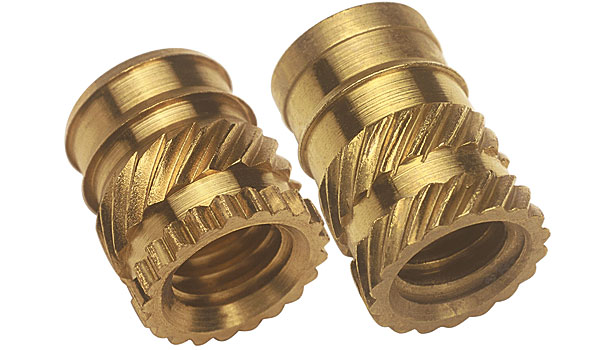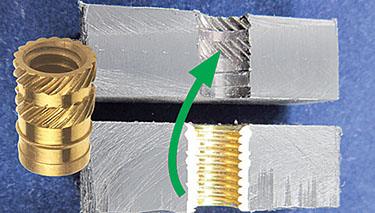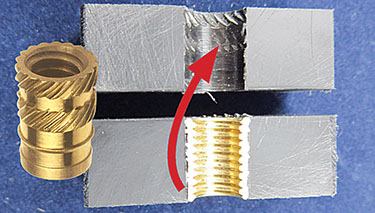News / Blog
Threaded Inserts: Ultrasonic vs Thermal Installation
Jan 02, 2020
AVF Inserts
RECENT POST
01/02/2020
What is Swiss Lathe? How does it works?
01/03/2020
How to install Treaded Inserts
When screws or bolts are threaded directly into plastic components, failures can occur due to stripped threads or plastic creep. (When plastic is exposed to static mechanical stresses or elevated temperatures, it can move or deform.) Threaded inserts provide serviceable threads for situations when joint strength and the ability to assemble and disassemble without degrading the components are required.
The two most common methods of installing threaded inserts are thermal and ultrasonic. But, they’re not the only methods. They can also be pressed in, molded in, and even screwed in via self-tapping threads. However, installation of inserts after molding reduces costs by shortening molding time. Post-mold installation also reduces the chance of scrap and mold damage resulting from dislodged inserts.
Thermal and ultrasonic installation can only be used with thermoplastic parts. Thermoplastics are solid at normal temperatures and can be remelted numerous times. Thermosets have a one-time reaction in their conversion from liquid to solid and cannot be remelted.
With both thermal and ultrasonic installation methods, the insert is embedded into a molded or drilled hole by remelting the plastic. Retention within the hole is provided by the melted plastic conforming to the external features of the insert. A sufficient volume of plastic must be displaced to entirely fill these external features so the insert achieves maximum performance when the plastic solidifies.
An accurate way of determining sufficient plastic flow into the knurls, barbs and undercuts of the insert is to take a cross section of the installed insert to see if its features are mirrored in the plastic. It’s important to ensure plastic flow into the features of the insert, since this dictates the fastener’s torque and pull-out performance.
Though they both rely on localized melting of the plastic, thermal and ultrasonic installation methods can result in varying performance. Both installation methods have advantages and disadvantages, which should be considered before investing in installation equipment.
Need custom made inserts? No problem. Contact us for details. AVF Inserts. Best inserts in Vietnam.

ARCHIVES
March 2015
Februari 2015
Januari 2015
Desember 2014
November 2014
TAGS
architecture
civil
engineering
construction
mechanical
eletrical
industrial
communication
electronics
tips
management
Since thermal installation requires heating the entire insert and not just the metal-plastic interface, the insert material should have excellent thermal conductivity. Brass and Aluminum are common choices. Photo courtesy from Spirol Corp.
Ultrasonic Installation
An ultrasonic insertion machine converts electrical power into mechanical vibrations. The downward force is typically provided by a pneumatic cylinder, while an ultrasonic horn delivers mechanical energy to the metal-plastic interface. Made from various metals, including titanium alloys, stainless steel and aluminum alloys, ultrasonic horns directly contact the metal insert. As the horn vibrates, the mechanical energy is transferred to the plastic surrounding the insert, creating frictional heat to melt the plastic.
Ultrasonic installation offers several advantages. First, it’s fast. Ultrasonic installation is generally fast for inserts less than 0.25 inch OD. (The process takes longer as insert size increases.) Second, the insertion machine can often be repurposed as an ultrasonic welder, directly joining two plastic parts. And third, it’s flexible. Horn sizes and shapes can be easily changed to accommodate different insert sizes.
Ultrasonic installation also has several disadvantages. One is insufficient melting of the plastic, and it can happen for several reasons.
For starters, poor fixturing of the parts can often result in cold pressing the insert. This occurs because of damping, or the dissipation of mechanical energy from the horn. Damping results in poor installation because the horn’s mechanical energy is not localized around the insert.
When inserts are driven too quickly, the plastic does not have time to fully melt. This is a common problem with ultrasonic insertion. The result is high stress and poor retention within the plastic, which can lead to part failure, either during initial installation of the mating screw or worse, in the field.
The vibratory forces applied via the horn are difficult to control, and sometimes parts are forced into the hole before melting has occurred. Damage to the insert or the plastic can be severe. While sophisticated control systems can help solve this problem, they can nearly double the cost of the insertion machine.
Finally, slight size variations of the insert or the hole can be enough to cause insufficient melt—even when insertion speed is slowed.
Another disadvantage of ultrasonic installation is the possibility of metal particulates. Minute metal flakes may appear when the ultrasonic horn vibrates against the insert and chips off the insert material.
Noise is another issue. The metal-to-metal contact between the horn and the insert can create a loud noise. The bigger the insert, the louder the noise.
With ultrasonics, it can be difficult to install multiple inserts simultaneously. It’s very costly, if not impossible, to install multiple inserts at the same time.
Insertion at the wrong frequency or down force can damage the insert. In some cases, the ultrasonic horn can damage the threads enough that the mating screw cannot be installed.
Extra caution must be taken when using nonheaded inserts to ensure proper contact is made between the insert and the horn. Otherwise, damage to the internal threads is likely to occur.
Finally, ultrasonic horns are expensive. Horns are subject to wear and are expensive to replace. A horn can often cost more than $1,000.


It's important to ensure plastic flow into the feature of insert, since this dictates the fastener's torque and pull-out performance. The left cross sectionshows how the plastic has conformed to the knurls on the insert. In the right cross section, the plastic did not sufficiently flow into the retention features. Photo courtesy from Spirol Corp.
Thermal Installation
Thermal installation is accomplished by transferring heat from the tip through the insert to the plastic, or by preheating the inserts and then pressing them in. In both cases, a controlled force is applied to the insert to ensure that the plastic is sufficiently melted before the insert is installed.
Since thermal installation requires heating the entire insert and not just the metal-plastic interface, the insert material should have excellent thermal conductivity. Brass and aluminum are common choices. This enables the insert to efficiently transfer heat to the plastic. It also enables the insert to cool down quickly after installation.
Once the plastic reaches its melting temperature, it fills the retention features of the insert and then solidifies, inducing minimal stress on the parts.
Ultrasonic insertion typically has a shorter cycle time than thermal insertion when installing a single insert that has not been preheated. However, thermal equipment that preheats the insert will have comparable installation time compared with ultrasonic equipment. In addition, when installing multiple inserts simultaneously, thermal insertion will offer faster throughput.
Thermal installation has several advantages
First, it’s reliable and consistent. Temperature, force and depth settings are adjustable. Lower installation forces enable fasteners to be inserted into thin-walled parts that would be destroyed by ultrasonic equipment.
Thermal installation is quieter than ultrasonic installation, and it’s also more economical. Thermal equipment is approximately 50 percent less expensive than similar ultrasonic equipment because they are less complex and do not require as many components. Thermal installation equipment is comprised of a heated tip and a pneumatic cylinder. Insertion force is low—generally less than 50 pounds. Ultrasonic installation requires an electronic power supply, electronic timers, a transducer and an ultrasonic horn.
Long tips can be designed so fasteners can be inserted into deep recesses within a part. Such areas would be inaccessible to an ultrasonic horn.
Thermal installation is versatile. Applications that need multiple inserts on multiple planes can be accommodated with platen-style thermal installation machines. Prototyping or low-volume applications can be accommodated with manual equipment. A wide range of insert sizes can be handled on the same machine by switching out the interchangeable heat tips. Any insert can be installed—headed or nonheaded.
Thermal insertion modules can be equipped with vibratory bowl feeders so the operator does not need to physically touch the insert during installation. The inserts are simply loaded into the feeder and advance through a tube to a guarded heating chamber. The operator would then load the plastic component into the fixture, and activate the machine to install the insert. This is important for very small inserts, which are difficult to singulate and orient.
Thermal installation machines seldom need maintenance. The maintenance and spare part costs are low. Replacement tips cost approximately $55.
Finally, thermal installation produces a high-quality joint due to the “through-heating” of the insert. This enables the melted plastic to fully flow into all retention features. Performance of inserts that are ultrasonically installed is often lower because the plastic is not able to fully flow into retention features. This happens because of the minimal heating generated only at the point of interference between the insert and the host.
As much as 75 percent of an insert’s performance is a direct result of how well it was installed. As a result, all the factors that affect installation must be carefully controlled to maximize performance. With so many different combinations of insert types, plastic types and performance requirements, engineers are well-advised to consult with experts on insert installation. The right choice of insert and installation method can be the difference between part failure in the field and part integrity for the intended life of the assembly.
Share this post
Christopher G. Jeznach
Jeznach, C. G. (2013, September 30). How to Install Threaded Inserts. Retrieved from https://www.assemblymag.com/articles/91577-how-to-install-threaded-inserts.
ABOUT US
AVF Inserts
subsidiary of VF Decolletage Co, Ltd.
Lot 11 Zone A1 Tan Thoi Hiep Ind Zone, W. Hiep Thanh D.12, HCMC, Vietnam.
Web: www.avfinserts.com - www.avfinserts.vn
Email: sales@avfinserts.com
Tel: +84.283.717.5001
Fax: +84.283.717.5278
AVF Decolletage
5754 Old Clifton Rd,
Clifton VA 20124, U.S.A.
Email: info@avfdecolletage.com
Tel: +1.571.393.3099
PRODUCTS
All Rights Reserved © 2020 | AVF Inserts

